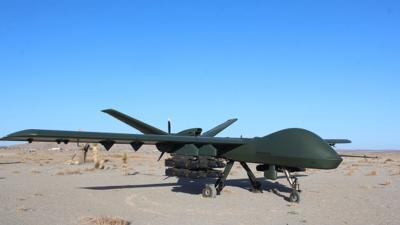Mojave STOL-Capable Tech Demonstrator Proves Durable & Capable
General Atomics Aeronautical Systems (GA-ASI) announced on 01 August 2023 that it had completed multiple successful takeoffs and landings of its Mojave Unmanned Aircraft System (UAS) on a dirt strip near El Mirage, California.

The ability to operate from unimproved surfaces demonstrates the Mojave platform's utility and the extent to which it departs from the limitations by which conventional fixed-wing aircraft are constrained. Moreover, the vehicle’s broadened capabilities afford users opportunity to deploy Mojave in areas previously deemed unsuitable for UAS operations.
General Atomics is an American energy and defense concern specializing in the research, development, and fielding of technologies germane to nuclear fission and nuclear fusion energy. The company also produces remotely operated surveillance aircraft, including the ubiquitous MQ-9 Reaper, as well as airborne sensors and advanced electric, electronic, wireless, and laser technologies.
GA-ASI President David R. Alexander stated: “Being able to execute missions in austere locations with runway independence opens the operational envelope for commanders across all services and geographic locations. Mojave can do this while retaining significant advantages in endurance and persistence over Vertical Takeoff and Landing (VTOL) and manned aircraft.”
The flight tests occasioned Mojave’s first-ever Short Takeoff and Landing (STOL) operations from a dirt surface. Takeoffs were performed in as little as 586-feet; short landings were completed in as little as 335-feet.
Impressive performance numbers notwithstanding, the Mojave flight-test campaign—rather than attempting to achieve the shortest takeoff and landing distances possible—focused primarily upon gathering terrain feedback utilizing the Mojave UAS.
In a general sense, Mojave is a STOL-capable technical demonstrator, the lineage of which is traceable to General Atomics’s MQ-1C Gray Eagle and MQ-9 Reaper UAS platforms. Adhering to Modular Open System Approach (MOSA) principles, Mojave leverages the modernized avionics, data-links, sensor-integration, and laptop ground control station of GA-ASI’s Gray Eagle 25M program. The antecedent features—in conjunction with Mojave’s enlarged, high-lift-device-fitted wings, combat-proven 450-horsepower turbine engine, and ruggedized landing gear—render the UAS uniquely well-suited to operations from semi- or unimproved-surfaces with a small ground-support footprint.
Mojave facilitates forward-basing operations in the absence of orthodox runways or airport infrastructure; ergo, the aircraft can be rapidly deployed from and recovered to non-traditional, discreet, and discrete locations.

To extend operational reach, Mojave can be rapidly disassembled, loaded into a C-130, transported per mission requirements, then be rapidly reassembled and deployed. Such innovations speak to Mojave’s fitness for Reconnaissance, Surveillance, and Target-Acquisition (RSTA), attack, and contested logistics support missions.
Designed and built to be rapidly deployable and expeditionary, Mojave’s features include a ruggedized airframe and weatherization conducive to operations in austere conditions and flight in wider environmental windows respectively. Robust wing storage allows Mojave to carry up to 16 Hellfire or equivalent missiles, assorted munitions, Launched Effects (LEs), or logistical resupply pods. Mojave provides greater operational flexibility while retaining a multi-sensor suite comprising: Electro-Optical/Infrared (EO/IR), Synthetic Aperture Radar/Ground Moving Target Indicator (SAR/GMTI), Electronic Intelligence (ELINT), and Signals Intelligence (SIGINT) to support land or maritime missions throughout Joint All-Domain Operations (JADO).
 NTSB Final Report: Rutan Long-EZ
NTSB Final Report: Rutan Long-EZ ANN FAQ: Turn On Post Notifications
ANN FAQ: Turn On Post Notifications Classic Aero-TV: ICAS Perspectives - Advice for New Air Show Performers
Classic Aero-TV: ICAS Perspectives - Advice for New Air Show Performers ANN's Daily Aero-Linx (06.28.25)
ANN's Daily Aero-Linx (06.28.25) Aero-News: Quote of the Day (06.28.25)
Aero-News: Quote of the Day (06.28.25)




